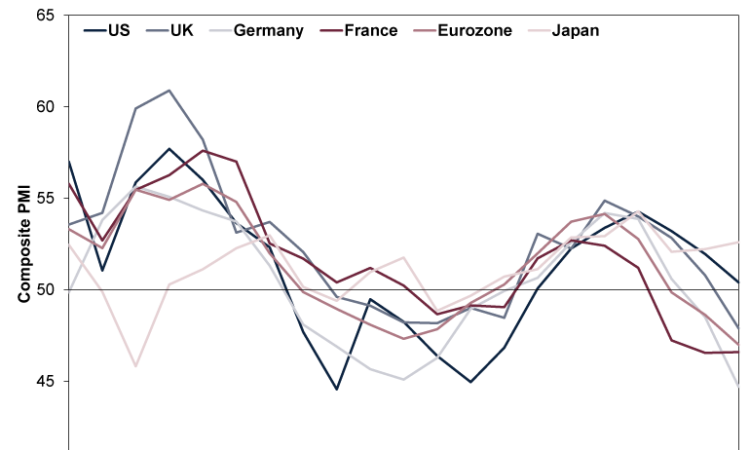
For the past several weeks, we have seen economic expectations inch higher—most notably in the US—as commentators we follow have started fathoming that inflation has eased without monetary policy institutions’ inducing recessions, a so-called soft landing.[i] Economists we follow started erasing recession forecasts instead of delaying them.[ii] But it seems all it took to reverse the positivity was a rocky August for stocks, coupled with some not-so-great Purchasing Managers’ Indexes (PMIs, monthly surveys that track the breadth of economic activity; readings above 50 indicate growth, below 50, contraction).[iii] With these surveys putting Europe in contraction, the US close to flat and only Japan in firm expansion, headlines we read are once again arguing recession is a foregone conclusion.[iv] We think that is a bit hasty. Yet even with that said, in our view, sentiment still seems dreary enough toward the weakest spots (Europe and the UK) that an actual economic downturn—if one struck—should have limited surprise power for stocks, which we find is key to their direction over meaningful timeframes.
Now, we don’t think August’s flash (preliminary) PMIs were great by any stretch. Yet this isn’t unprecedented: As Exhibit 1 shows, composite readings (which combine services and manufacturing output) spent much of 2022’s second half (and in some cases beyond) under 50, suggesting more firms contracted than grew. Outside Germany, however, this didn’t translate to a recession.[v] Gross domestic product (GDP, a government-produced measure of economic output) wobbled a tad in Japan, the eurozone and some member states, but it kept growing in the US and to a lesser extent the UK.[vi] Therefore, we think it is premature to declare recession is a sure thing now. It may be. It may not be.
Exhibit 1: A Composite PMI Double Dip
Source: FactSet and S&P Global, as of 23/8/2023.
The points in favour of a recession are the aforementioned sub-50 PMI readings, which mean a majority of businesses are reporting contraction. But there are also counterpoints, in our view. For one, PMIs measure growth’s breadth (how many businesses grew or contracted) but not its magnitude (how much firms grew or contracted). So if the minority of firms that reported growth notched a big enough expansion to outweigh the contracting majority, then output could still grow. As noted earlier this week, this is the current trend in US and UK manufacturing. In both places, manufacturing output has defied contracting manufacturing PMIs for months.[vii] Eurozone output is choppier, but it hasn’t been uniformly in the red since PMIs first notched contraction last summer.[viii]
Two, the composite readings could be overweighting manufacturing. Exhibits 2 and 3 break manufacturing and services out separately. As Exhibit 2 shows, with a couple of exceptions, manufacturing has been negative for a year. This probably isn’t good, but manufacturing is a small piece of developed-world economies.[ix] Even in Germany, widely considered an industrial powerhouse amongst commentators we follow, manufacturing is just 18% of GDP.[x] Services generates the lion’s share of output, and it isn’t contracting across the board.[xi] The US and Japan’s services sectors remain above 50—signalling expansion—whilst Germany, the UK and the eurozone only just slipped below. Only French services have contracted for more than a month.
Exhibit 2: Manufacturing PMIs
Source: FactSet and S&P Global, as of 23/8/2023.
Exhibit 3: Services PMIs
Source: FactSet and S&P Global, as of 23/8/2023.
If services’ multi-month contraction last year didn’t correspond with recessions outside Germany, we think it seems strange to equate August’s falling PMIs with broad economic trouble now. Minor deviations have happened before, and this could be another. And if not? We think recession talk has lingered long enough to keep surprise power at a minimum. Yes, we have heard a lot of soft landing chatter in the US, but nascent positivity there was an outlier, in our view. In the UK, economists we cover remain preoccupied with rising living costs, BoE rate hikes and a perceived lack of meaningful domestic growth drivers.[xii] We have seen similar concerns from the eurozone, with an added dose of renewed energy jitters. We didn’t see many celebrations when Germany’s contraction paused and eurozone growth resumed in Q2.[xiii] The reaction we observed there was one we often see during early bull markets: Just wait, the real trouble lies ahead.[xiv] To us, it suggests a continued downturn would mostly just meet dreary expectations, whilst eking out growth would probably be a positive surprise.
In our view, none of this precludes further stock market volatility, which we know can be an unpleasant prospect with global stocks down about -4% from their year-to-date high and UK stocks enduring a correction.[xv] Pullbacks and even full-fledged corrections (sharp, sentiment-fuelled drops of about -10% to -20%) have happened in bull markets’ first years before.[xvi] Sometimes weak economic data spur that reaction. Sometimes not. Regardless of the cause, we think enduring short-term wobbles is part of the price we all pay to achieve stocks’ long-term returns. Our research finds these wobbles also begin and end when people least expect it, making gritting your teeth and toughing it out the only realistic option for those seeking market-like returns over time, in our view.
[i] “Americans Haven’t Been This Optimistic About Inflation in Two Years,” Alicia Wallace, CNN, 12/6/2023. Inflation refers to broadly rising prices across the economy. A recession is a period of contracting economic output.
[ii] “Economists Lift US Growth Forecasts, See Fed Higher for Longer,” Augusta Saraiva and Sarina Yoo, Bloomberg, 12/8/2023. Accessed via Yahoo! Finance.
[iii] Source: FactSet, as of 24/8/2023. Statement based on MSCI World Index return in GBP with net dividends, 1/8/2023 – 24/8/2023.
[iv] Source: FactSet and S&P Global, as of 24/8/2023.
[v] Source: US National Bureau of Economic Research, UK National Institute of Economic and Social Research, Euro Area Business Cycle Network and Japan Cabinet Office, as of 23/8/2023. Statement based on each entity’s business cycle dating committee.
[vi] Source: Japan Cabinet Office, European Commission, Office for National Statistics and US Bureau of Economic Analysis, as of 24/8/2023. Statement based on GDP readings in each country, Q2 2022 – Q2 2023.
[vii] Source: US Federal Reserve and Office for National Statistics, as of 24/8/2023.
[viii] Source: Eurostat, as of 24/8/2023.
[ix] Source: World Bank, as of 24/8/2023.
[xii] “The Looming Inflation Threat Facing Britain,” Szu Ping Chan and Tim Wallace, The Telegraph, 17/8/2023. Accessed via MSN.
[xiii] Source: Eurostat and Destatis, as of 24/8/2023. Statement based on Eurozone and Germany GDP, Q2 2023.
[xiv] Bull markets are long periods of generally rising equity prices.
[xv] Source: FactSet, as of 24/8/2023. Statement based on MSCI World Index return in GBP with net dividends and MSCI UK IMI total return, 1/8/2023 – 22/8/2023.
[xvi] Source: FactSet, as of 24/8/2023. Statement based on MSCI World Index return in GBP with net dividends, 31/12/1969 – 24/8/2023.






